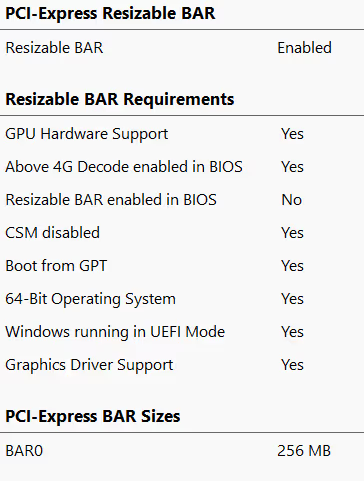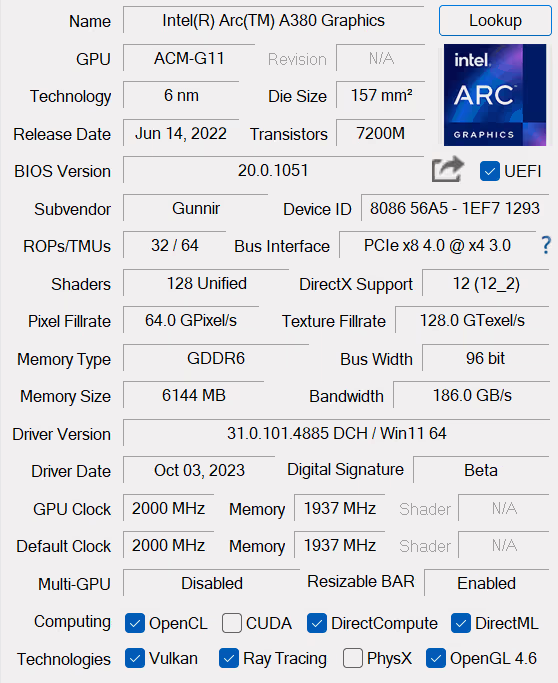Intel ARC A750 and A380 as eGPU for GPD Win Max 2
After testing RDNA graphics cards as eGPU solution for GPD Win Max 2 I've decided to go through Intel Arc cards. This would be an AMD CPU laptop with an Intel dedicated GPU. Curious how that would sound like a few years ago.
So the test setup is Win Max 2 with Ryzen 7840U (24W TDP), 32GB LPDDR5x 7200MT/s RAM, and a BIWIN PCIE 4 SSD running Windows 11 (11.0.22621), and Intel Arc drivers 31.0.101.4885.
The primary goal was to test eGPU over OCuLink performance but sadly, for now, I'm unable to make Intel Arc work with this laptop over OCuLink - it's something related to boot process not detecting it. What's lest is USB4 and a Thunderbolt 3 eGPU dock. PCIe 3.0 x4 over Thunderbolt 3 is less efficient thant pure PCIe 4.0 x4 over OCuLink. For one slower specs of PCIe and the second is CPU managing Thunderbolt alongside other I/O which causes some extra CPU load. I'm planning to check two other OCuLink boards and see if those will help me get Arc detected when I get them.


Benchmark results
I tested A750 in two configurations - with an external display connected directly to the GPU via HDMI (marked as external
) and in internal
configuration where the laptop's own display is used. When a laptop display is used some of the PCIe bandwidth is used to send the rendered frames back, so it lowers performance and is not optimal. Also when in internal
mode I could not run some benchmarks on the Arc GPU - FFXIV Endwalker benchmark or Unigine benchmarks did not see the eGPU, only 3DMark (and it does warn about suboptimal configuration as well). When the display was switched to external the problematic benchmarks did run.
As this is a benchmark with GPUs running over Thunderbolt 3 the results will be lower than what those GPUs get in a normal PC.

Time Spy gave a bit mixed results. For one the CPU score isn't consistent (it was for RDNA2 GPUs), yet on the graphics side, we can see A380 over TB3 getting above integrated 780M by a slight margin, while A750 getting more than double the scores.

Night Raid both for RDNA2 and now Intel Arc has severe performance drops when using the laptop's own screen as if the benchmark was very sensitive to GPU connection throughput. The CPU score is consistent across all configurations.

3DMArk PCIe Bandwidth resulted in almost 1,4 GB/s for both Arc cards. API overhead test for limited connections like this can also be used as a measure of throughput. A380 got almost 3 million draw calls/s and A750 slightly more, in line with a slightly better PCIe bandwidth test. Depending on the cable, and docking station the TB3 PCIe connection may not reach its full potential or even fail.
The API overhead test is not actively supported, so it may give weird results. 19 million draw calls/s for 780M while RX 6950 XT managed almost 8,5 millions/s. Take this test with a grain of salt.

In other benchmarks A380 was slightly better than 780M, losing only in Unigine Superposition. 3DMark Solar Bay is a cross-platform lightweight ray tracing benchmark, while 3DMark Wild Life is a cross-platform Vulkan based benchmark.

And in an old DX11 benchmark A380 manages to win noticeably. Not bad for Intel graphics cards running over TB3.
Troubleshooting and future benchmarks
This was mostly a synthetic benchmark run, trying to judge stability, potential issues, and other oddities. Some actual games and wider reference setups will be done a bit later.
I'll be testing two other OCuLink boards to see how those behave. On top of that, I have some options in the laptop BIOS. Not sure if anything can be done about the resizable bar, but I'll check as well.
And as an end note - what about a laptop with AMD CPU, Intel GPU, and Nvidia 2.5/10Gbit networking?
Comment article